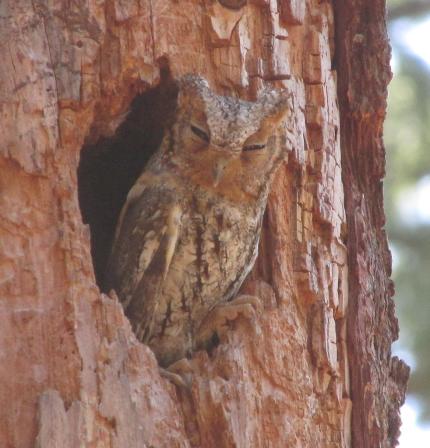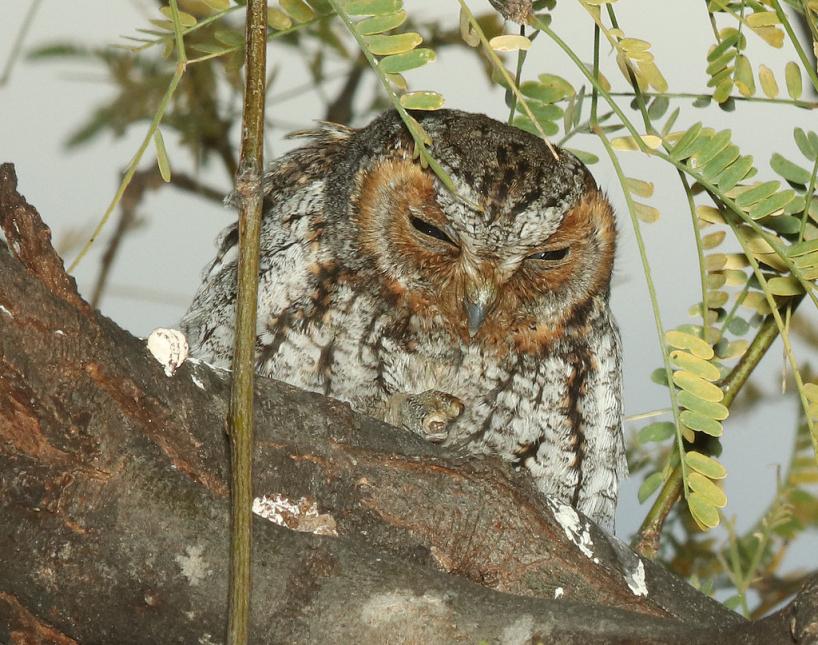The Washington population of flammulated owl is low and trend is unknown. These owls inhabit dry montane forests of eastern Washington and are probably impacted by habitat loss and degradation as well as by fire suppression in these landscapes.
Description and Range
Physical description
The flammulated owl is a small (6 to 7 inches long) dark-eyed owl, more often heard than seen. They have small ear tufts. There is a red and a gray plumage phase of this owl. Flammulated owls are known for their hollow-sounding, single or paired hoots.
Ecology and life history
The flammulated owl is most strongly associated with mid- and late-seral ponderosa pine forests with an open canopy cover, a presence of large (greater or equal to 20 inches) cavity trees or snags, and at least some areas of dense foliage (perhaps used as protective cover) within an otherwise generally open understory. For nesting, they generally prefer larger cavities excavated by pileated woodpecker or northern flicker, or occasionally a natural cavity of appropriate size.

The flammulated owl is the only Neotropical migrant owl in North America. It breeds in western North America and migrates to Mexico and Guatemala. In Washington, it is found in dry forests where pairs occupy small territories. The species has a low annual rate of reproduction. Rates of nest success and productivity in Washington are not known.
Prey items are generally dominated by insects, including moths.
The maximum recorded longevity of a flammulated owl in the wild is about seven to eight years.
Geographic range
The flammulated owl appears to be uncommon and is found in ponderosa pine and other dry forest regions on the eastern slope of the Cascade Range, the Kettle Range, Selkirk Mountains, and Blue Mountains. Surveys conducted in Washington found the species most often in ponderosa pine and dry Douglas-fir forests, but also in other forest types. Studies from other parts of the species’ range have concluded the species may be somewhat more common than originally thought. The size of Washington’s breeding population is unknown.
For a map of range-wide distribution and conservation status of this species, check out NatureServe Explorer.
Climate vulnerability
Sensitivity to climate change
Low-
Moderate
Flammulated owls may be sensitive to temperature and moisture; upper limits of owl occupancy may be set by low nocturnal temperatures or high humidity while lower limits may be set by high diurnal temperatures or high humidity. In addition, changes in temperature may alter the availability of primary prey species (e.g., insects), which may influence their distribution. Flammulated owls are habitat specialists, requiring old-growth ponderosa pine and/or Douglas-fir stands, making them vulnerable to changes in habitat extent and quality due to shifting wildfire regimes, precipitation changes, and habitat loss or degradation.
Exposure to climate change
Moderate
- Increased temperatures
- Changes in precipitation
- Altered fire regimes
Conservation
Conservation Threats and Actions Needed
- Fish and wildlife habitat loss or degradation
- Threat: Effects of fire suppression.
- Action Needed: Develop and implement dry forest management and restoration programs.
- Agriculture side effects
- Threat: Loss of ponderosa pine forest (and other dry forest) and nest cavities by either fire, live tree harvest or dead trees for firewood. Decreasing lepidopteran insect prey (butterflies, moths, and skippers) due to use of pesticides in forest management.
- Actions Needed: Promote protection and effective management of dry forests using a variety of tools including prescriptive management that retains adequate numbers and diameters of large (≥20 inches) snags and live trees for future recruitment.
See the Climate vulnerability section for information about the threats posed by climate change to this species.
Resources
References
Buchanan, J. B. 2005. Flammulated Owl (Otus flammeolus). Pp 211-212 in T. R. Wahl, B. Tweit, and S. G. Mlodinow (eds.) Birds of Washington: Status and Distribution. Oregon State University Press, Corvallis, OR, USA. 436 pp.
Linkhart, B. D. and D. A. McCallum (2020). Flammulated Owl (Psiloscops flammeolus), version 1.0. In Birds of the World (A. F. Poole, Editor). Cornell Lab of Ornithology, Ithaca, NY, USA. https://doi.org/10.2173/bow.flaowl.01
McCallum, D. A. 1994. Flammulated Owl (Otus flammeolus). The Birds of North America 93:1-24.
